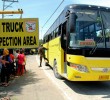Groups of indigenous peoples from all over the country are set to hold protests during the commemoration of the 20th year of the Philippine Mining Act of 1995.
Piya Macliing Malayao, spokesperson for the Kalipunan ng Katutubong Mamamayan ng Pilipinas (KAMP), “the law had legalized wholesale land-grabbing of ancestral lands by mining corporations, and is considered as the largest threat to the survival of indigenous peoples across the nation.”
Malayao said that the indigenous peoples “have suffered the worst from dislocation and environmental destruction caused by liberalized mining espoused by the Mining Act of 1995.”
According to a KAMP’s study on existing mining permits, five of the six Financial Technical Assistance Agreements (FTAA) were located within the ancestral lands of indigenous peoples. Also in IP territories were 148 of the 339 approved Mineral Production Sharing Agreement (MPSA), 23 of the 61 Exploration Permit (EP), 30 of the 84 Mineral Processing Permits (MPP), and 45 of 222 industrial sand and gravel operations.
“More than 60 percent of all mining permits, amounting to 607,779 hectares encroach on ancestral lands of indigenous peoples,” Malayao said.










